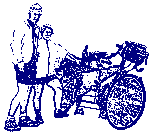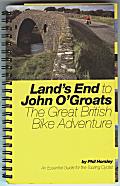
Tips for preparing for the ride

How to get to one end and from the other?
- Train - This is good if you have an easy service to/from somewhere near your home. It's certainly the most environmentally friendly way of transporting you and your tandem. See below for more detail.
- Car - OK if you have a tandem carrier (we don't) and a willing person to drive all that way. Don't forget that it's a round trip of 2000 miles or so for someone to take you to the start and go to collect you at the other end. That's a lot of petrol, time and pollution!
- Bus - probably not very practical. I've no experience of this to offer – sorry!
Booking trains
- We travelled from Sheffield so can only offer comments on that journey. There is a leaflet available from stations called "Cycling by train" which details which rail companies offer what. We found this invaluable.
- Trains from Sheffield
offer a straight through service to Penzance on Virgin, who also carry
tandems for the cost of two bikes (£3 each). Space is limited so book
in advance.
(Update June 2001 (see below for later update): as of 20th May 2001 Virgin are no longer prepared to carry tandems. If you feel strongly about this, please write to them, and to other organisations such as the CTC, the Tandem Club and BikeRail. It may be that Virgin can be persuaded to change their minds if enough of us express our opinions. The 2001 issue of "Cycling by Train", available at railway stations, presents the current situation regarding tandem carriage.)
(Update February 2002: After some correspondence and representations from CTC and the Tandem Club, and others, Virgin do now carry tandems once more. You may have to insist when booking, although the 2002 edition “Cycling by Train” leaflet says tandems are carried. It seems that Virgin are also doing their best to provide tandem accommodation on their new “Voyager” trains which were not originally designed to take tandems. Many thanks to all involved in bringing about this welcome change.)
- Trains in the far north don't carry tandems (Scotrail do carry pre-booked single bikes though). You need to get back to Inverness for a mainline train which will carry tandems (this involves about 120 extra miles of cycling). Again, book this in advance to be sure of a space for the tandem. Great North Eastern offer a straight through service via York and Peterborough but there's no link to Sheffield with tandem carrying facility. We arranged to be picked up at York by car with a borrowed tandem carrier.
|
Route planning
|
 |
|
|
Checking the bike
- Get it serviced
properly - this is essential! Either do it yourself or get your
local bike shop to do it. 1000 miles is a long way and your bike will
be carrying more weight than usual so it will suffer. Our tandem was
only 2 years old and had only done about 2000 miles before we set off
and even we suffered a few mechanical problems. An old, poorly maintained
bike will almost certainly let you down!
When we were at John O' Groats, we got talking to two lads who had arrived the same evening as we did. They had had terrible problems including 19 punctures and many broken spokes resulting, eventually, in the total collapse of a wheel necessitating about a 30 mile walk. Breakdowns rarely happen close to a bike shop and on this trip you can be a long way from help. They only completed the trip by borrowing another bike. Get your bike serviced!
Things to check particularly: rims and rim tape, tyres and tubes, brakes, bearings, transmission, use oil on the chains often especially after rain even though the stoker gets oily legs! It was probably a lack of oil that caused our middle chainring to wear out. Also make sure that your bike is set up for you properly so that you are comfortable.
Accommodation:
- B&B - comfort, good breakfast, plentiful which means it's not essential to plan the route around available accommodation – can find a B&B towards the end of the day when you know how far you've travelled, little need to book in advance, costly (around £20 per person per night in 2000)
- Youth Hostels - no experience to offer, cheap, not so plentiful so route needs careful planning and is therefore less flexible. May be other advantages I don't know of due to lack of experience.
- Camping - a lot of extra weight to carry, perhaps need a trailer, need to know where camp sites are and route needs planning around their availability, cheap, least comfortable, may be a lack of sites in northern Scotland but could wild camp (with permission).
- Cost: for us — 3 weeks in B&B + meals, trains and other costs = about £1500. Expensive business!
